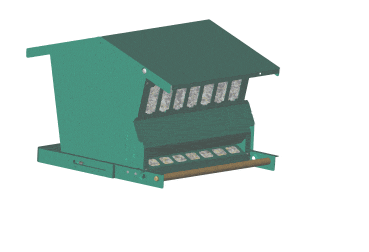

|

|
Heritage Farms Nature Oriented Products
|
|
|
Century Tool & Manufacturing Company, Inc. is
a growth-oriented market and customer-driven organization providing
quality engineered products and services of outstanding value to the
leisure time, nature products, and other diversified worldwide
markets. The Heritage Farms division of Century Tool & Mfg. Co.
was conceived in 1989 with the goal of offering to the consumer an
assortment of the highest quality outdoor nature-oriented products that
could be produced and provide a value.
I believe we have achieved that goal with our line of
adjustable metal feeders, plastic feeders and related accessory
products. As we enter our second decade, we will continue to develop
and offer to the consumer innovative, quality products at a reasonable
price.
Roger E. Lundstrom
President
Century Tool &
Mfg. Co., Inc.
|
 |
Bird Feeding Tips
-
When placing your feeder, allow privacy for the birds. Avoid
areas where there is excessive noise from dogs, driveway traffic, and slamming
doors. Use a location that is as quiet and undisturbed as possible. Set the
feeder back several yards from the window so indoor activities will not scare
the birds away. Normally, a corner of the yard near some shrubs or a fence is
ideal. Bushes permit a social arena where birds may light, preen, search for
food and maintain pecking order. Where your yard meets deciduous trees and
where the shrubbery ends and garden begins all serve as mini-habitats. These
areas offer the interspersing of plants and perches that birds love to
utilize. By taking advantage of little "waste areas" in your yard you will be
able to provide the privacy needed to maintain a population of feeding station
visitors.
-
When setting up your new feeder, wipe off the feeder with a damp
cloth. It takes time for birds to become used to something new in their
environment. To help attract birds, sprinkle seed on the ground under the
feeder.
-
Do not be discouraged if it takes time for birds to respond to a
new feeder. Frequency of feeding can depend on where you live, the number of
trees and other feeders in your area. A poor winter at the feeder -- low
numbers, few species -- is usually a sign of a mild winter or abundant natural
food rather than some sort of catastrophe.
-
Birds eat grit along with their food to help them digest it.
During the winter, you can scatter sand near the feeder to help the birds,
since natural grit may be frozen or hard to find.
-
Cardinals, blue jays and house sparrows are often the first
visitors to a new feeder. When titmice, woodpeckers and nuthatches begin
coming in, you've established an effective feeding station. |
|
|






 Woodside Gardens
The Registry of Nature Habitats
Woodside Gardens
The Registry of Nature Habitats 
 1999 -
1999 -


